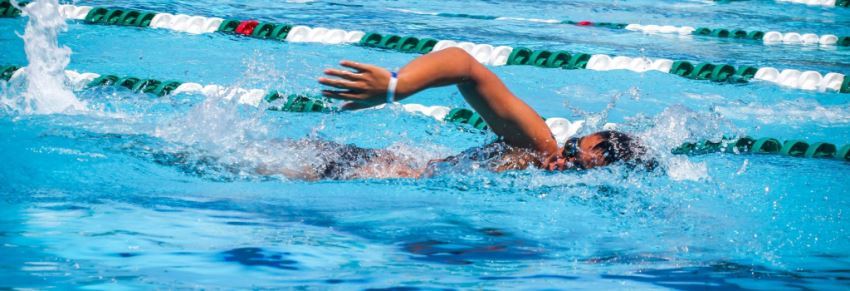Swim Tip
Presented by Andrew Fleek, Camp Director
Nike Swim Camp Tip: Breathing Patterns

Swimming is unique to all other sports in that the athletes aren’t able to breathe whenever they want – only when their face is out of the water. In other sports when athletes are under maximal exertion the typical respiratory rate is between 50 and 70 breaths per minute. That is definitely not true in swimming. Depending on the race and individual swimmer, the typical respiration rate is anywhere from 16 to 30 breaths per minute.
Swimmers swim faster when they do not turn their head to breathe. The dilemma for swimmers is that if they restrict their breathing too much while racing, they will reduce their oxygen supply and become more fatigued, while breathing too often will decrease their speed. Therefore, choosing the correct breathing pattern for the race one is swimming is crucial to success. Keep in mind that a swimmers age, experience, and skill level will also play a role in determining the proper breathing pattern for different races.
50’s
In a 50, it is the buildup of carbon dioxide in the body that causes the pain swimmers experience, not a lack of oxygen. The race is too short for oxygen to make it from the lungs to the muscles, so breathing will not increase their oxygen supply. Because 50’s involve such a rapid energy expenditure in such a short time a large amount of CO2 is produced, swimmers will need to expel that CO2 to decrease the pain they feel.
There are several popular breathing patterns used successfully by swimmers in 50’s. Just because one pattern works best for someone doesn’t mean that it will work for you – it is important to experiment to find the best pattern for each individual swimmer.
• A Three-Breath Pattern has breaths around 15, 25-30 (depending on short course/long course), and 40 yd distances. Many describe this method as One Down, Two Back.
• A Two Breath Pattern can have one breath 7 to 10 yds from the wall, and a second breath near the half way mark on the way back. Others prefer taking no breaths on the first 25, and two on the second 25.
• A One Breath Pattern is typically only appropriate for older swimmers. Usually the breath occurs about one-third into the second 25.
100’s
100’s offer more complex problems when it comes to breathing because a compromise must be struck between increasing speed by not breathing and delaying fatigue by increasing oxygen supply. Swimmers are generally more successful if they take more breaths during the first half of a race. This is because the oxygen inhaled takes several seconds to get from the lungs to the muscles – meaning that the air taken in during the first quarter of a race fuels the second quarter etc. Some popular methods are:
• Breathe once every other stroke cycle for the first 25, and every stroke cycle for the next 75
• Breathe once every other stroke cycle for the first 50, and every stroke cycle for the next 25
• Breathe every other stroke cycle for the entire 100
Again, experimentation is key. The proper pattern for many swimmers will be unique to them depending on age, skill level, and where the breaths occur in relation to walls and turns.
For more swim tips and instruction like this from Andrew Fleek join him this summer at the Nike Swim Camp at Lawrence University. The 2023 Wisconsin swim camp at Lawrence University is offering three sessions of overnight, extended day (9:00am-8:00pm) and day camp (9:00am-4:00pm) for ages 9-18. Camp dates are June 12-15, June 18-22 & July 10-13.
